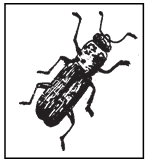Location: Termites usually nest in the soil, but occasionally in humid conditions, above the ground. Subterranean termites make tunnels or tubes of soil and excretions that act as a protection and gateway to the food source. Termites must maintain regular contact with the soil, as they need the moisture to survive. These tunnels are a very distinctive clue to termite infestation. They attack wet or dry wooden structures within the reach of the soil. The damaged wood will resemble the pages of a book.
As a general rule, termites are found at or near ground level. Only seldom do they occur above the level of the first floor. Anywhere that wood is in close contact to the earth, termite damage can occur. Basements and crawl spaces are especially vulnerable.
Control and Extermination: Cavities in wood which are not visible from the surface can be located by tapping on the wood and listening for the hollow sound. Cavities can be detected by probing the wood with a tool such as a screwdriver or a pocket knife. Failure to locate termites in the tubes does not mean that they are not present in the structure.
Where the tunnels are moist and strong, termites are active. Extermination should be handled by a professional. The chemical treatment can be expected to last up to 20 years. It is injected into the soil around the building, through the basement floor and foundation, as well as through any posts or other penetrations. This creates a chemical envelope around the house. The cost of treatment varies, but it typically is $1,200 plus the cost of any wood/soil breakage.





